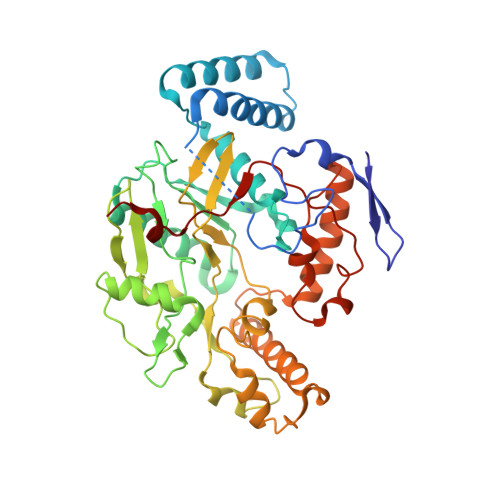Nitrile in the Hole: Discovery of a Small Auxiliary Pocket in Neuronal Nitric Oxide Synthase Leading to the Development of Potent and Selective 2-Aminoquinoline Inhibitors.
Cinelli, M.A., Li, H., Chreifi, G., Poulos, T.L., Silverman, R.B.(2017) J Med Chem 60: 3958-3978
- PubMed: 28422508
- DOI: https://doi.org/10.1021/acs.jmedchem.7b00259
- Primary Citation of Related Structures:
5UNR, 5UNS, 5UNT, 5UNU, 5UNV, 5UNW, 5UNX, 5UNY, 5UNZ, 5UO0, 5UO1, 5UO2, 5UO3, 5UO4, 5UO5, 5UO6, 5UO7, 5UO8, 5UO9, 5UOA, 5UOB, 5UOC, 5UOD - PubMed Abstract:
Neuronal nitric oxide synthase (nNOS) inhibition is a promising strategy to treat neurodegenerative disorders, but the development of nNOS inhibitors is often hindered by poor pharmacokinetics. We previously developed a class of membrane-permeable 2-aminoquinoline inhibitors and later rearranged the scaffold to decrease off-target binding. However, the resulting compounds had decreased permeability, low human nNOS activity, and low selectivity versus human eNOS. In this study, 5-substituted phenyl ether-linked aminoquinolines and derivatives were synthesized and assayed against purified NOS isoforms. 5-Cyano compounds are especially potent and selective rat and human nNOS inhibitors. Activity and selectivity are mediated by the binding of the cyano group to a new auxiliary pocket in nNOS. Potency was enhanced by methylation of the quinoline and by introduction of simple chiral moieties, resulting in a combination of hydrophobic and auxiliary pocket effects that yielded high (∼500-fold) n/e selectivity. Importantly, the Caco-2 assay also revealed improved membrane permeability over previous compounds.
Organizational Affiliation:
Department of Chemistry, Department of Molecular Biosciences, Chemistry of Life Processes Institute, Center for Molecular Innovation and Drug Discovery, Northwestern University , 2145 Sheridan Road, Evanston, Illinois 60208-3113, United States.



















